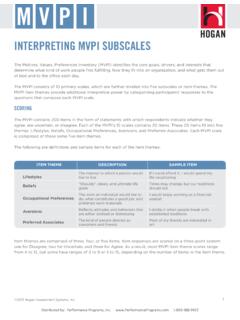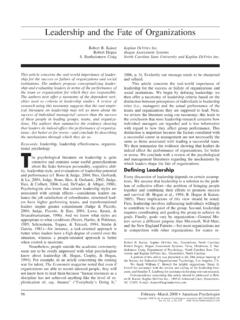Transcription of Subscale Interpretive Guide - Hogan Assessments
1 Subscale Interpretive Guide HDS. HO GAN D E V E LO P ME NT S U RVE Y. T H E S C I E N C E O F P E R S O N A L I T Y. Subscale Interpretive Guide The Hogan Development Survey (HDS) is the industry standard for assessing derailers counterproductive behavioral tendencies that emerge in times of stress and complacency. Organizations around the world rely on the HDS for identifying behaviors that disrupt or interfere with effective performance. Learning and development professionals understand the value of the HDS for shedding light on critical blind spots, increasing strategic self-awareness, and driving personal growth.
2 They also know coaching, when coupled with HDS results, can help individuals manage problematic tendencies. THE EVOLUTION OF THE HDS. Hogan updated items and added subscales to the HDS in keeping with our philosophy of Kaizen Psychometrics, which is the belief in continually improving our Assessments based on research and experience. These improvements build on the unique measurement properties of the HDS and bring a new level of precision to the assessment of derailment patterns. New features include: 1. subscales : Derailers are multi-faceted. Derailment behaviors are complex and multi-faceted.
3 Over the years, we have observed a growing need and customer demand for the inclusion of subscales to assist in the interpretation of HDS profiles. Although inherently imbedded within the HDS, subscales were not originally defined or presented in reports. Perhaps the most exciting improvement to the HDS, the new subscales provide in-depth insight into the many faces of derailment. HDS Subscale results are available on the Challenge, Flash, and Insight Reports. On these reports, each of the 11 derailers feature a subset of three underlying behavioral themes. Similar to the scoring of HDS primary scales, each Subscale is scored as a risk rating indicating the strength of the behavior and degree to which the theme contributes to the overall score.
4 2. Low Score Implications: Deeper insight into underused strengths. Although high-risk derailers pose the greatest threat to leadership effectiveness in the form of overused strengths, extreme low scores can represent underused strengths. In other words, high scorers may get fired; low scorers may get overlooked. This does not diminish the view of higher scores, but demonstrates the value of examining the full range of scores on a given scale. New low-score features with the HDS include: Definitions for both high and low scores on each HDS Subscale Additional training on low scores in Hogan 's advanced certification workshops New options for coaching individuals whose HDS profiles do not include any elevated scores 3.
5 Psychometric Properties: Enhanced measurement mechanics. Hogan regularly evaluates and updates our inventories to ensure they exceed the highest standards of testing excellence. Enhancements are essential to maintaining our commitment to advancing the science of personality assessment. Psychometric improvements made to the HDS include: Replacement of outdated assessment items Updates to the HDS norms Additional validation work to ensure the effective prediction of workplace behaviors 2. Subscale Interpretive Guide INTRODUCTION. The HDS predicts behaviors critical to career success.
6 The evolution of the HDS builds on what we have learned from years of research and application of the assessment, resulting in greater prediction of critical behaviors and enhanced ability to interpret results. Interpretive Guidelines Below are Interpretive guidelines and ground rules to keep in mind: Best Practices Cautions The whole is greater than the sum of its parts; Avoid over-emphasizing or over-generalizing as with all Hogan tools, the primary interpretative subscales . The validity and predictive power of a focus should always remain at the main scale single Subscale is too narrow to stand alone.
7 Level. Use the subscales for deeper, more nuanced Context matters; avoid over-analyzing individual understanding of behaviors driving the overall subscales or interpreting their meaning in a scale. vacuum. Keep in mind the risk rating for each Subscale Avoid drawing conclusions about low-risk scores mirrors the risk thresholds for overall scale (40-69%); these fall in an Interpretive gray area, scores, ranging from no to high risk. which means behavioral inferences cannot be made. Focus on moderate- to high-risk ratings (70- Interpret no-risk (0-39%) scores cautiously if 100%).
8 Advanced users may also evaluate no risk you do not have extensive HDS experience and scores (0-39%). have not attended advanced Hogan certification workshops. Use the information you gain through analysis of It is not advised to reference subscales the subscales to identify specific developmental directly during a debrief; rather, incorporate targets/actions that will deliver the greatest the information into your overall analysis and impact. feedback. Look for opportunities to draw connections Remember: there are 125 sub-dimensions across between the HDS subscales , as well as to other the three Hogan tools: 42 HPI subscales , 33.
9 Behavioral themes emerging on the HPI and MVPI HDS subscales , and 50 MVPI item theme scores. Assessments . It is not useful to examine every one; focus on extreme scores and those with the greatest impact. 3. Subscale Interpretive Guide SAMPLE PROFILES. Example 1 High Skeptical score with subscales Dimension Score Percentile Skeptical 90. Prone to doubt others' intentions and assume they Cynical have bad ulterior motives. Generalized mistrust of people and institutions;. Mistrusting being alert for signs of perceived mistreatment. Holding grudges and being unwilling to forgive real or Grudges perceived wrongs.
10 Interpretation: This individual scored at the 90th percentile on Skeptical. People scoring in the high-risk zone are often described as bright and perceptive, but cynical, fault-finding, and alert for signs of betrayal. This example represents a classic high-risk Skeptical case; all three of the subscales contribute to this individual's scale score. The elevation of all three subscales suggests the full spectrum of negative behavioral themes associated with the main scale are likely to emerge when the person is not actively self-monitoring. The Grudges Subscale contributes slightly less to the overall score on Skeptical, but is still an area in which the individual should be aware and continue to monitor.







